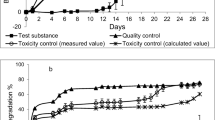Summary
Wastewater from syntheses of s-triazines was analyzed.This real waste differed from the model wastes for which a triazine-degrading pseudomonad had been isolated.The pseudomonad, while able to grow, did not degrade a significant portion of the s-triazines.
Similar content being viewed by others
References
Beilstein, P., Cook, A. M. and Hütter, R. (1981).J. Agric. Food Chem. 29, 1132–1135.
Bergmeyer, H. U. (1977).Grundlagen der enzymatischen Analyse. Verlag Chemie, Weinheim.
Cook, A. M. and Hütter, R. (1981).J. Agric. Food Chem. 29, 1135–1143.
Cook, A. M. and Hütter, R. (1982).Appl. Environ. Microbiol. 43, 781–786.
Cook, A. M., Beilstein, P. and Hütter, R. (1983a).Int. J. Environ. Anal. Chem. 14, 93–98.
Cook, A. M., Grossenbacher, H. and Hütter, R. (1983b).Experientia 39, 1191–1198.
Cook, A. M., Grossenbacher, H., Hogrefe, W. and Hütter, R. (1983c). Biodegradation of xenobiotic industrial wastes: applied microbiology complementing chemical treatments. InBiotech '83, pp. 717–724. Online Publications, Northwood, UK.
Geller, A. (1980).Arch. Environ. Contam. Toxicol. 9, 289–305.
Greenberg, A. E., Connors, J. J. and Jenkins, D. (1981).Standard methods for the examination of water and wastewater, edn 15, pp. 383–388. American Public Health Association, New York.
Knackmuss, H.-J. (1981). Degradation of halogenated and sulfonated hydrocarbons. InMicrobial degradation of xenobiotics and recalcitrant compounds, T. Leisinger, A. M. Cook, R. Hütter and J. Nüesch, eds. pp. 198–212. Academic Press, London.
Knackmuss, H.-J. (1983). Biochem. Soc. Trans. in press.
Lehninger, A. L. (1975).Biochemistry, 2nd. ed. Worth, New York.
Munnecke, D. M. (1981). The use of microbial enzymes for pesticide detoxification. InMicrobial degradation of xenobiotics and recalcitrant compounds, T. Leisinger, A. M. Cook, R. Hütter and J. Nüesch, eds., pp. 251–269. Academic Press, London.
Schocken, M. J. and Speedie, M. K. (1982).Bull Environ. Contam. Toxicol. 29, 101–106.
Thom, N. S. and Agg, A. R. (1975).Proc. R. Soc. (London) Ser. B: 189, 347–357.
Zeyer, J. (1979). Dissertation No. 6446, Eidgenössische Technische Hochschule, Zürich.
Author information
Authors and Affiliations
Rights and permissions
About this article
Cite this article
Cook, A.M., Hogrefe, W., Grossenbacher, H. et al. Biodegradation of xenobiotic compounds: Problems of enzyme specificity and wide substrate spectrum in real wastes containings-triazines. Biotechnol Lett 5, 843–848 (1983). https://doi.org/10.1007/BF01386659
Issue Date:
DOI: https://doi.org/10.1007/BF01386659



